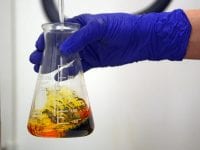Are you 100% sure you know what AN (acid number) measures and what it reveals? Actually A LOT of things! According to Monika Malcolm, Analytical Services Manager for TestOil, “Acid number is measuring acidic components in the oil sample. These can include degradation products such as organic acids, esters, and salts as well as contaminants such as inorganic acids, and certain additives such as detergents and inhibitors. “
So, on one level AN just measures acid—more importantly, AN will let you know if you need to take a harder look at what may be causing the acid—serious issues can stem from antioxidant depletion. When antioxidants have been consumed, oxidation of the lubricant will ensue, producing acidic compounds and increasing the acid number.
There is a misconception that AN just detects the lubricant’s level of acidity, but it goes beyond that to detecting the concentration of specific acids present in the lubricant-both weak organic acids and strong inorganic acids. Pinpointing the concentration of acidic contaminants allows for understanding the extent of additive depletion, a change in oil type, or degradation.
The acidic byproducts formed due to oxidation can lead to machine damage stemming from corrosive wear. Monika cautions, “Acidic conditions can result in corrosion of machine components. High acid number due to lubricant degradation products can also promote accelerated lubricant degradation and may contribute to formation of sludge or varnish.”
Monitoring the AN and taking action can head all this off.
AN measurement involves diluting a portion of the sample and then titrating it with a basic solution to a specific endpoint (ASTM method-D974). The result expresses how much titrant is needed to neutralize the acids in the sample aliquot.
All industrial lubricating oils and some combustion engine oils are excellent candidates for AN. However, this test is not appropriate for high water content fluids such as water glycols and oil/water emulsions. Monitoring other parameters such as viscosity and FTIR oxidation along with acid number can provide a more complete picture of the lubricant condition. “Get the Picture” is an eBook focusing on understanding what your lubricant analysis reports are really saying and covers results analysis for acid number and a variety of other tests.
For more information on working with TestOil for oil analysis and training visit www.testoil.com. Contact: 216-251-2510; sales@testoil.com.
About TestOil
With more than 30 years of experience in the oil analysis industry, TestOil focuses exclusively on assisting industrial facilities with reducing maintenance costs and avoiding unexpected downtime through oil analysis program implementation. As industry experts in diagnosing oil-related issues in equipment such as turbines, hydraulics, gearboxes, pumps, compressors and diesel generators, TestOil provides customers with a guarantee of same-day turnaround on all routine testing. With in-house, certified training professionals, TestOil offers lubrication and oil analysis training, private onsite training, certification training and exams, and educational webinars. For more information on partnering with TestOil on oil analysis programs or training opportunities visit www.testoil.com.


